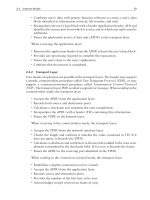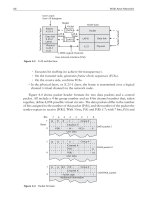Lecture Data Communication: Lesson 16
Bạn đang xem bản rút gọn của tài liệu. Xem và tải ngay bản đầy đủ của tài liệu tại đây (873.22 KB, 30 trang )
DATA COMMUNICATION
Lecture-16
Recap of Lecture 15
Types of Digital-To-Digital Encoding
Unipolar Encoding
Polar Encoding
Bipolar Encoding
Overview of Lecture 16
Analog-to-Digital Conversion
Pulse
Amplitude Modulation (PAM)
Pulse
Code Modulation (PCM)
Quantization
Binary Encoding
Digital-To-Digital Conversion
Conversion Methods
Types of Digital-to-Digital Encoding
Digital/Digital Encoding
Unipolar
Polar
Bipolar
Analog-to-Digital Conversion
Analog-to-Digital Conversion
The most common technique to change an analog
signal to digital data (digitization) is called pulse
code modulation (PCM). A PCM encoder has three
processes, as shown
1. The analog signal is sampled.
2. The sampled signal is quantized.
3. The quantized values are encoded as streams of bits.
Pulse Code Modulation (PCM)
Modifies pulses created by PAM
Four Separate Processes:
PAM
Quantization
Binary Encoding
Digital/Digital Encoding
Pulse Code Modulation (PCM)
Sampling
Amplitude Modulation (PAM)
Pulse
First step in Analog-to-Digital Conversion
This technique takes an Analog signal,
Samples it, and Generates a series of
Pulses based on the results of Sampling
Sampling
Amplitude Modulation (PAM)
Pulse
Sampling
The first step in PCM is sampling. The analog
signal is sampled every Ts , where Ts is
the sample interval or period. The inverse of
the sampling interval is called the sampling
rate or sampling frequency
Sampling
Amplitude Modulation (PAM)
Pulse
There are three sampling methods-ideal,
natural, and flat-top-as
Sampling
Amplitude Modulation (PAM)
Pulse
In ideal sampling, pulses from the analog signal are
sampled. This is an ideal sampling method and cannot be easily
implemented.
In natural sampling, a high-speed switch is turned on for
only the small period of time when the sampling occurs. The
result is a sequence of samples that retains the shape of the
analog signal.
The most common sampling method, called sample and
hold, however, creates flat-top samples by using a circuit.
Pulse Amplitude Modulation (PAM)
The sampling process is sometimes referred to as pulse
amplitude modulation (PAM)
Sampling Rate
How many samples are sufficient?
Nyquist theorem:
The sampling rate must be at least
twice the highest frequency
Sampling Rate
Sampling Rate
Example 4.6
For an intuitive example of the Nyquist theorem, let us sample a
simple sine wave at three sampling rates: fs = 4f (2 times the
Nyquist rate )'/s = 2f (Nyquist rate), and f s =f (one-half the
Nyquist rate). Figure 4.24 shows the sampling and the subsequent
recovery of the signal.
Sampling Rate
Quantization
Quantization is a method of assigning
integral values in a specific range to the
sampled instances
Quantization
The following are the steps in quantization:
1. We assume that the original analog signal has
instantaneous amplitudes between
Vmin and Vmax'
2. We divide the range into L zones, each of height ~
(delta)
3. We assign quantized values of 0 to L - I to the midpoint
of each zone.
4. We approximate the value of the sample amplitude to
the quantized values.
The following are the steps in quantization:
1. We assume that the original analog signal has
instantaneous amplitudes between
Vmin and Vmax'
2. We divide the range into L zones, each of height ~
(delta)
3. We assign quantized values of 0 to L - I to the midpoint
of each zone.
4. We approximate the value of the sample amplitude to
the quantized values.
Quantization
Quantization Levels
The choice of L, the number of levels, depends on the
range of the amplitudes of the analog signal and how
accurately we need to recover the signal. If the
amplitude of a signal fluctuates between two values
only, we need only two levels; if the signal, like
voice, has many amplitude values, we need more
quantization levels. In audio digitizing, L is normally
chosen to be 256; in video it is normally thousands.
Choosing lower values of L increases the quantization
error if there is a lot of fluctuation in the signal.
Quantization
Quantization Error
One important issue is the error created in the quantization
process. Quantization is an approximation process. The input
values to the quantizer are the real values; the output
values are the approximated values. The output values are chosen
to be the middle value in the zone. If the input value is also at
the middle of the zone, there is no quantization
error; otherwise, there is an error. In the previous example, the
normalized amplitude of the third sample is 3.24, but the
normalized quantized value is 3.50. This means that there is an
error of +0.26. The value of the error for any sample is less
than.~/2. In other words, we have -.:-~/2 <=error <=~/2
Quantization
Binary Encoding









